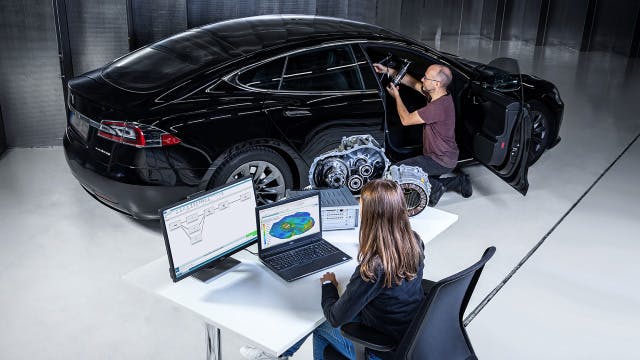Historically, NVH validation occurs when a physical prototype is available. However, building physical prototypes for every variant within a reasonable timeframe and budget is impossible with the explosion of vehicle variants. And while electrified vehicles may be quieter, other noise sources have become more audible, requiring more attention. Simultaneously, modular platforms are increasing the importance of vehicle controls to assess the impact of design decisions on NVH performance.
In this on-demand webinar, discover a solution that allows anyone in an organization to assemble a vehicle using test and simulation-based
component data to explore assembly alternatives virtually before building the physical prototype. Register to watch now!
Virtually assemble a vehicle prototype to frontload NVH performance
With vehicle NVH performance prediction, NVH teams can accurately predict a vehicle's interior and exterior NVH performance at any stage of the development cycle. It allows combinations of test and simulation-based component models, sources, or passive components and uses them to create assemblies. Our solution offers an easy and interactive way of making assemblies using calculations that run seamlessly behind the scenes to replace components and evaluate design alternatives virtually and effortlessly.
Enable vehicle NVH prediction at any stage during the development
NVH prediction results can be evaluated and interactively analyzed in different interactive views, with a focus on the core responsibility of each person to maximize the usage of the virtual prototype assembly application. Typical examples include road noise assessment, pass-by noise interactive evaluation, booming noise analysis, or complex load and controls scenarios from hybrid electrified vehicles. Our NVH prediction solution also allows teams to evaluate the virtual assembly's NVH performance subjectively by driving it on the vehicle NVH simulator.
Road noise prediction – an MBSE approach to virtual NVH development
Vehicle NVH prediction methodologies such as component-based transfer path analysis (TPA) or virtual prototype assembly (VPA) are often used to solve road noise. Siemens offers solutions to improve vehicle comfort by predicting the NVH performance of a virtually assembled vehicle at any stage during development.
Read the blog “4 steps to predict road noise – a project with Hyundai Motor Group” and discover how Sangyoung Park from Hyundai Motor Group uses a test-data-driven MBSE approach to accurately predict road noise, focusing on the vehicle body, suspension, and tire.
Renault expands NVH prediction applications 5x while reducing physical prototypes
Renault partnered with Simcenter to implement a holistic, company-wide process to reliably assess the NVH performance of an assembled vehicle virtually without a physical prototype.
Building on Simcenter Engineering expertise and Simcenter Testlab Virtual Prototype Assembly software, they developed new methods with improved reliability and accuracy of prediction, such as the interaction between strongly coupled components. Additionally, they enabled better collaboration between teams earlier in the development, supporting any test or computer-aided engineering (CAE) based data source internally or from suppliers.
Manage all vehicle components in a central database with Simcenter Testlab
The unique strength of our NVH performance solution lies in the solid fail-safe process, fit for anyone within the organization. Test and CAE experts can publish component models in total confidence, using templates with the possibility to save them in a central database. While this
database grows over time, analysts and engineers can search and retrieve this data, assemble it, and assess specific NVH performance characteristics without detailed knowledge of the used components. And by creating a comprehensive digital twin, teams can understand the impact of design decisions on NVH performance before a physical prototype is available.
Watch the on-demand webinar to learn more about maximizing data usage while leveraging team collaboration by centrally managing and sharing NVH data.
Meet the speaker

Bart Verrecas
Simcenter Business Development Team Manager
2005 – Master in Mechanical Engineering at the KU Leuven, Belgium.
15 years of experience at Siemens, where he built up his expertise in NVH testing with a focus on the automotive industry.
Today, Bart Verrecas is a Business Development Team Manager for Automotive NVH & Durability Testing, heavily involved in discussions with numerous automotive OEM’s on how to increase NVH testing efficiency.
